I am starting to use CGAL to triangulate a set of points using the following code
#include <iostream>
#include <CGAL/Exact_predicates_inexact_constructions_kernel.h>
#include <CGAL/Delaunay_triangulation_2.h>
#include <CGAL/Triangulation_vertex_base_with_info_2.h>
typedef CGAL::Exact_predicates_inexact_constructions_kernel K;
typedef CGAL::Triangulation_vertex_base_2<K> Vb;
typedef CGAL::Triangulation_face_base_2<K> Fb;
typedef CGAL::Triangulation_data_structure_2<Vb,Fb> Tds;
typedef CGAL::Delaunay_triangulation_2<K,Tds> Triangulation;
typedef Triangulation::Point Point;
typedef Triangulation::Triangulation_data_structure tds;
using namespace std;
void main()
{
Triangulation t;
t.insert(Point(0,0));
t.insert(Point(0,20));
t.insert(Point(30,15));
t.insert(Point(30,-15));
Triangulation::Finite_faces_iterator fib = t.finite_faces_begin(), it;
Triangulation::Finite_faces_iterator fie = t.finite_faces_end();
Triangulation::Triangle tri;
std::cout << "Triangular faces"<<endl;
for (it=fib; it!=fie; ++it)
{
tri = t.triangle(it);
std::cout<<tri[0]<<" "<<tri[1]<<" "<<tri[2]<<" "<<endl;
}
char c;
std::cin>>c;
}
This prints the faces as 0,20 0,0 30,15 and 0,0 30,-15 30,15. I am not satisfied with this output as the first triangle is completely inside the second. As I understand triangulation it should return 3 triangles and not just 2 covering the complex hull of my 4 input points, and there should be no overlapping triangles. Could someone explain what I am doing wrong ?
My ultimate goal is to triangulate a convex polygon under a minimum angle constraint (and by addin additional points to the set). Any CGAL code sample would be appreciated.
Thanks,


